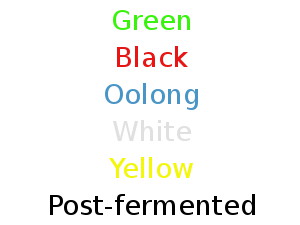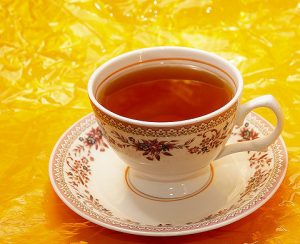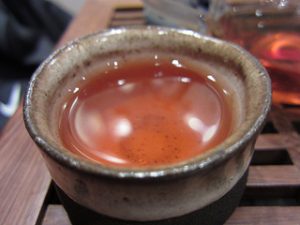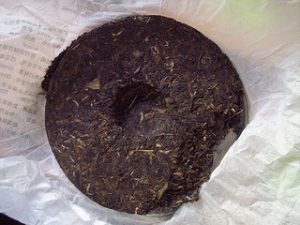 Did you know that what we call black tea is known as red tea in Asia, and that there’s also blue tea?
Did you know that what we call black tea is known as red tea in Asia, and that there’s also blue tea?
On a previous post, I wrote about the types of tea: green, black, oolong, white, yellow, and post-fermented. However, those colors only apply to western countries.
The Chinese classification is also used in Japan, and as far as I know, Korea. Because tea originated in China, this classification can be thought of as the “original”.
I can’t speak/write Chinese, but since this is a Japanese tea blog, let me go ahead and write each type as they do in Japan: 緑茶 (ryokucha, green tea), 紅茶 (koucha, red tea), 青茶 (seicha/aocha, blue tea), 白茶 (hakucha/shirocha, white tea), 黄茶 (kicha, yellow tea), and 黒茶 (kokucha/kurocha, black tea).

Koucha (red tea)
This is the tea that we call black tea. If you’ve ever drank iced tea before, then you’ve surely tried this type of tea.
I haven’t looked up the details, but it seems that the British made a translating error early on when trading with China, and that’s why we know it as black tea, instead of red.
Occasionally the term “red tea” is used when referring to rooibos tea, which isn’t really a tea, but rather a tisane made from a plant cultivated in South Africa.
Japan makes it’s own black tea, called wakoucha.

Seicha or Aocha (blue tea)
Both in the US and Japan this is better known as oolong. It’s popular in Japan, there’s even bottled oolong for sale in vending machines.
But why is it called “blue tea”? It certainly doesn’t look blue at all.
The reason is that in ancient Asia, both green and blue where thought of as being the same color! Now there are modern words for green and blue, respectively, but back in the time this tea was named, the meaning was a different tone of green, kind of like teal.
In Japanese, people still call green apples “ao ringo” (青りんご, blue apple) and the traffic green light signal is called “ao shingo” (青信号, blue signal).

Kokucha or Kurocha (black tea)
The Asian black tea refers to post-fermented tea, which can also be called dark tea.
The most famous example is pu-erh tea. In Japan it has a similar name: pu-arucha (プーアル茶).
What’s your favorite color? You can easily tell what’s mine 🙂





January 9, 2013
Yellow tea (hwangcha) in Korea refers to something more like oolong tea than Chinese yellow.
January 9, 2013
Thanks for the clarification, Sam. I like Korean teas but they are still kind of rare in the US, so I don’t know much about them yet : )
January 9, 2013
Green and blue the same colour? Makes me wonder whether there is a genetic difference in colour distinction?
I have seen oolong also classified as blue-green. Makes sense if it was the same word.
January 9, 2013
To answer my own question. A quick google search told me that it has to do with language development and not genetically being able to see the difference.
It happened in many languages,
It also seems that there are more colour distinctions not made in a language before green and blue get their own terms.
January 9, 2013
Thanks for the research, Bram!
January 10, 2013
I didn’t know they had a name for white tea in Japan. Tell me, have you run into any Japanese-grown white tea? It’s on my two-drink list…if it exists. So is Japanese oolong.
January 10, 2013
Thanks for the comment, Geoff.
The reason the Japanese have a name for each Chinese tea type is that they use the same (or similar) Chinese characters, it’s just the pronunciation that changes.
I’ve never seen Japanese-grown white tea, I think all of it is imported. However, there is certainly Japanese black tea, oolong and dark tea.
October 12, 2016
Japanese White Tea exist and seems to be very rare limited product:
http://www.yuuki-cha.com/japanese-white-tea/organic-japanese-white-tea-zairai
October 12, 2016
Thanks for the info 🙂